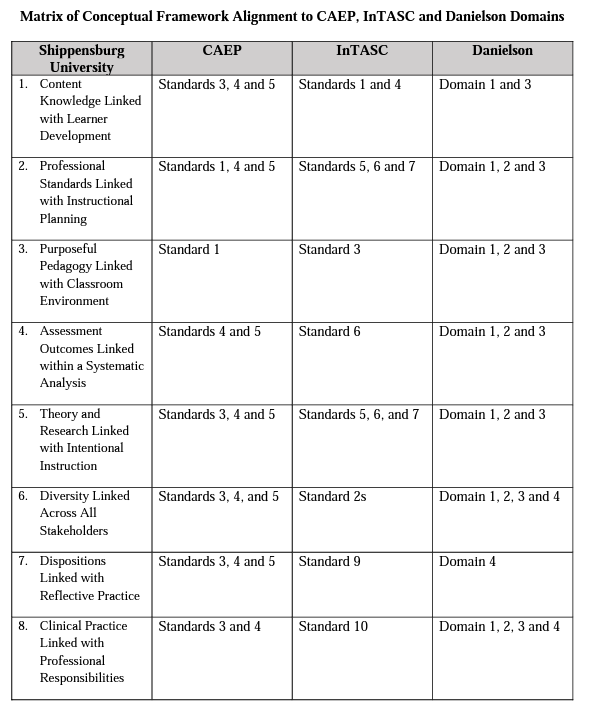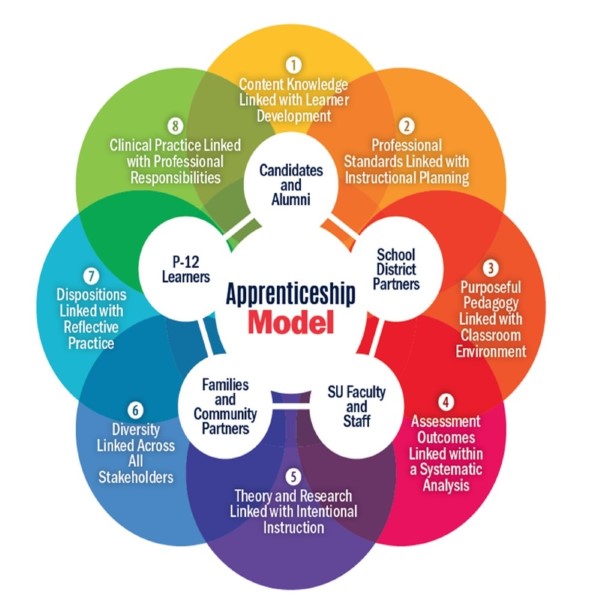Conceptual Framework
Apprenticeship Model: Synthesizing Concepts in Collaboration with Experts
Shippensburg University presents a Unit with certification programs including a diverse group of candidates studying in various fields of education. These candidates are both novice learners in their field of study as well as teachers seeking advanced certification in such fields as Reading, Educational Leadership, Counselor Education and Special Education. They require mentors who serve as content knowledge specialists as well as professional experts. These mentors are usually University faculty and experts from our clinical settings. The Apprenticeship Model represents various factors that scaffold our candidates within a gradual release of responsibility in PK-12 educational and clinical settings. There are eight factors that represent a spoke in Shippensburg University’s Conceptual Wheel. The spokes represent principles of our unit’s academic and experiential structure. The spokes include: National Standards, Content Knowledge, Diversity, Assessment, Instructional Planning, Theory and Research, Dispositions and Professional Standards and Pedagogy.
Shippensburg University’s conceptual wheel represents the mechanism that steers our candidates as they travel through our Unit’s academic and experiential learning outcomes. The Helmsman are the experts, including faculty and area professionals, who guide the Apprenticeship candidates as they learn to navigate and synthesize expectations associated with their field of study. Helmsman also serve as guides that chart the path for a candidate’s development of knowledge, skills and dispositions associated with each of the programs. The faculty gradually release the wheel to candidates as they take on the responsibility of professional practice in PK-12 educational and clinical settings.
Goals for the Conceptual Framework Apprenticeship Model
Our faculty and candidates are committed to implementing the following eight standards that have been collaboratively designed by members of the unit. These standards include:
- Content Knowledge Linked with Learner Development: Candidates Comprehend, Apply and Value Discipline-Based Knowledge in Classrooms and Communities. (CAEP Standards 3, 4, and 5, InTASC Standards 1 and 4, Danielson Domain 1 and 3)
- Professional Standards Linked with Instructional Planning: Candidates Plan and Examine Standards-Based Instruction and Integrated Technology Use to Impact Learning in Classrooms and Communities. (CAEP Standards 1, 4, and 5, InTASC Standards 5, 6, and 7, Danielson Domain 1, 2, and 3)
- Purposeful Pedagogy Linked with Classroom Environment: Candidates Implement and Evaluate Instructional Methods to Impact Learning Outcomes in Classrooms and Communities. (CAEP Standards 1, InTASC Standard 3, Danielson Domain 1, 2, and 3)
- Assessment Outcomes Linked within a Systematic Analysis: Candidates Evaluate and when appropriate Redesign Instruction to Strengthen Learning Outcomes in Classrooms and Communities. (CAEP Standards 4, 5, InTASC Standard 6, Danielson Domain 1, 2, and 3)
- Theory and Research Linked with Intentional Instruction: Candidates Use Data Driven Evidence and Decisions to Impact Learning and Development in Classrooms and Communities. (CAEP Standards 3, 4, and 5, InTASC Standards 5, 6 and 7, Danielson Domain 1, 2, and 3)
- Diversity Linked Across All Stakeholders: Candidates Demonstrate a Respect for All Students’ Diverse Learning Needs in Classrooms and Communities. (CAEP Standards 3, 4, and 5, InTASC Standard 2, Danielson Domain 1, 2, 3, and 4)
- Dispositions Linked with Reflective Practice: Candidates Contemplate Attitudes, Skills and Beliefs to Ensure Fair and Equitable Treatment of Learners and Professional Partners in Classrooms and Communities. (CAEP Standards 3, 4, and 5, InTASC Standard 9, Danielson Domain 4)
Clinical Practice Linked with Professional Responsibilities: Candidates Collaborate with Partners in Classrooms and in Communities. (CAEP Standards 3 and 4, InTASC Standard 10, Danielson Domain 1, 2, 3, and 4)
 The Outcomes:
The Outcomes:
The framework for the Apprenticeship Model allows the Shippensburg University to contextualize the documentation of undergraduate, graduate and doctoral candidates’ learning outcomes in relation to our philosophy, our mission and our Conceptual Framework competencies. Key assessments have been collaboratively designed and vetted by an Assessment System Protocol. Each assessment is linked to a specific point in time so that we ensure that we are not only evaluating candidates’ knowledge, skills, and dispositions, but that we are also continuously documenting candidates’ professional growth and development. In addition, each competency is linked to CAEP/INTASC, SPA, and PDE standards to ensure alignment with national and state compliance expectations for accreditation.
Professional Dispositions:
Candidates' professional dispositions in relation to the Apprenticeship Model Conceptual Framework include four distinct categories:
- Professional Learning and Ethical Practice-candidates' commitment to his/her profession.
- Critical Thinking and Reflective Practice-candidates' growth and development as an emerging professional.
- Leadership, Interaction and Collaboration-candidates' commitment to building relationships with peers, professionals, and the community.
- Stewardship for Diversity-candidates' personal and professional value of a diverse society in which all people are treated fairly and equitably.
Candidates’ dispositions are evaluated from three perspectives, the candidate, a clinical supervisor and a cooperating teacher or clinical mentor. Key Assessment Instruments are designed to ensure that robust and ongoing evidence of professionalism across multiple semesters is collected and analyzed.


